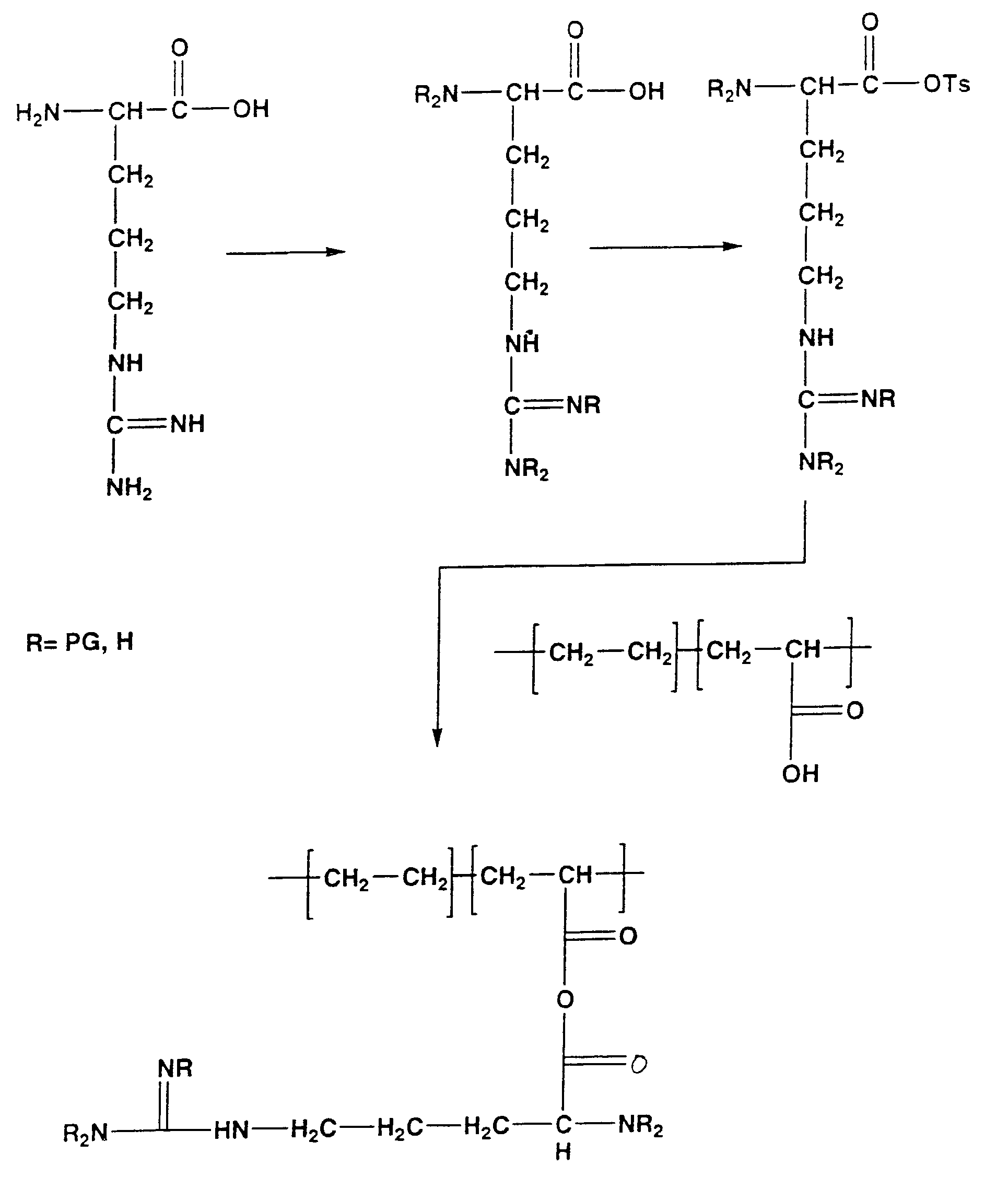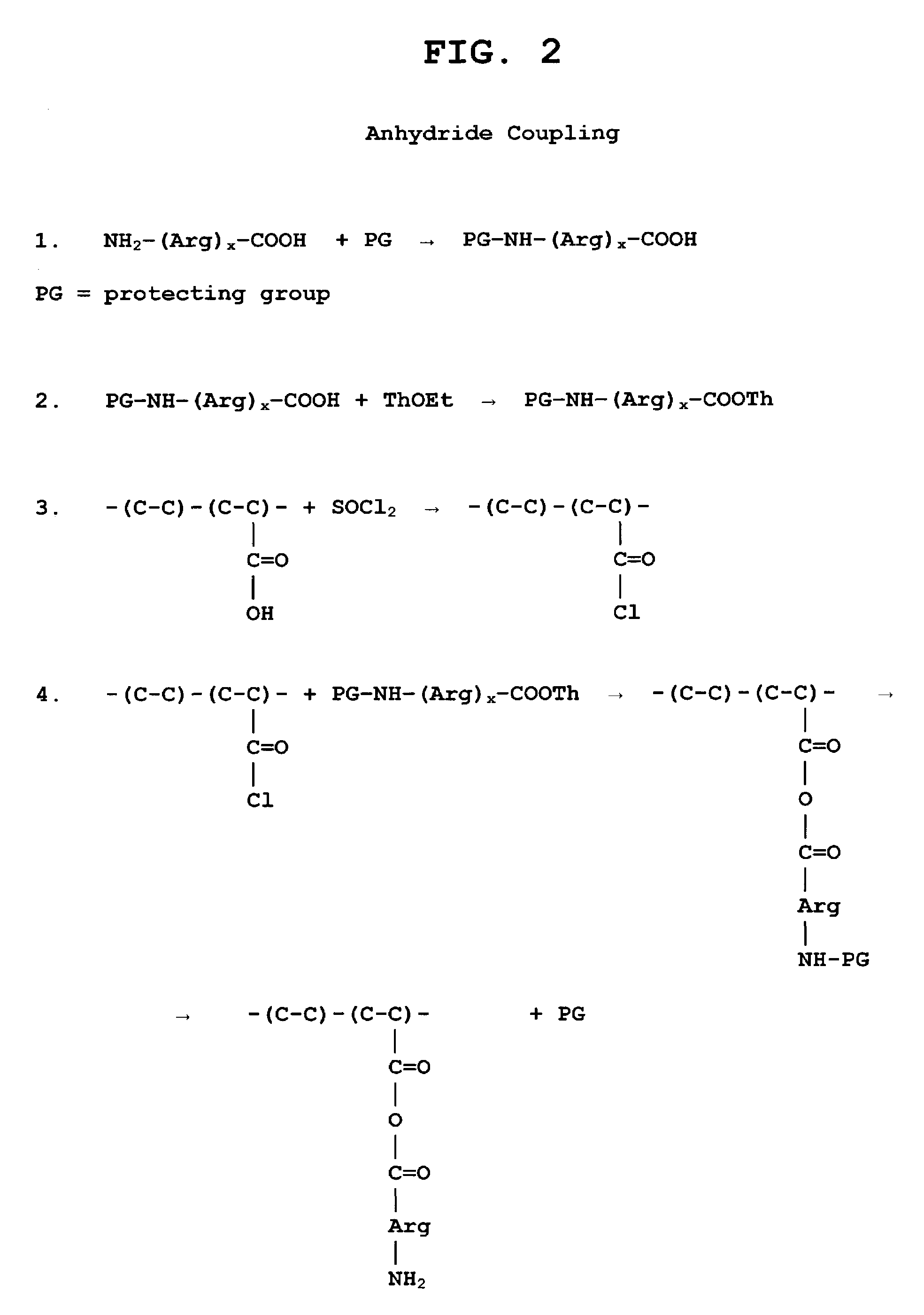Biocompatible carrier containing L-arginine
a carrier and biocompatible technology, applied in the field of biocompatible carriers containing larginine and larginine oligomers, can solve the problems of intimal flaps or torn arterial linings which can collapse, obstruct the conduit, and produce adverse or toxic side effects for patients, and achieve efficient and sustained effects
- Summary
- Abstract
- Description
- Claims
- Application Information
AI Technical Summary
Benefits of technology
Problems solved by technology
Method used
Image
Examples
example 1
Synthesis
[0057]To a 100 ml roundbottom flask is added a stirbar, condenser and nitrogen bubbler. Nitrogen is bubbled through the reaction flask. The EVAL is added to the flask and purged with nitrogen. Anhydrous DMAC is added to the flask using a cannula and nitrogen to push the nitrogen into the reaction flask. The flask is heated to 60° C. for 3 hours to dissolve the EVAL polymer. The polymer solution is then cooled to room temperature and the Nα-9-fluorenylmethoxycarbonyl (FMOC)-L-arginine is added and after about 2 minutes of stirring went into solution. The solution is then cooled to 0° C. and the 1 M dicyclohexylcarbodiimide (DCC) solution in methylenechloride (MeCl2) is added dropwise. After the DCC is added, a crystal of dimethylaminopyridine (DMAP) is added to catalyze the esterification process. The solution is then stirred at 0° C. for 2 hours and allowed to warm to room temperature. The solution is then stirred under nitrogen for overnight. After stirring overnight, a si...
example 2
Purification
[0059]The suspension is then added to a separatory funnel. To a flask is added 450 ml of water, 450 ml of methanol with 25 ml of 1N HCI. To the flask is then added the precipitate suspension in a dropwise manner. A white polymer is precipitated from the acidic methanol / water media, which is stirred for 15 minutes and then filtered under vacuum. The polymer is then re-dissolved in DMSO, filtered through a glass frit filter and re-precipitated into methanol / water forming a white fluffy precipitate. The sample is then dried under vacuum for overnight. The sample is extracted with methanol to remove residual DMAP and urea and dried under vacuum.
example 3
Deprotection of FMOC from EVAL-(FMOC-L-arginine) Ester
[0060]To a roundbottom flask with a condenser and nitrogen source is added anhydrous N,N-dimethylacetamide, EVAL-(FMOC-L-arginine) ester and tetrabutylammonium fluoride. In the reaction of the deprotection, it is assumed that the yield for the esterification step is 100%. The calculations are shown in Table 2.
[0061]
TABLE 2Deprotection Reaction ReactantsReactantsAmountEVAL-(FMOC-L-arginine)ester0.7696gDMAC50mlTetrabutylammonium fluoride1.3688g
[0062]To a reaction flask is added the EVAL-(FMOC-L-arginine) ester and anhydrous DMAC under nitrogen. The sample is stirred and heated to 60° C. for 3 hours until the derivatized EVAL polymer went into solution. The solution is then cooled to room temperature. After the solution is cooled to room temperature, tetrabutylammonium fluoride is then added at room temperature, after which the solution turned a pink-red color. The solution is then stirred for 30 minutes.
PUM
| Property | Measurement | Unit |
|---|---|---|
| temperature | aaaaa | aaaaa |
| polymeric | aaaaa | aaaaa |
| hydrolyzable | aaaaa | aaaaa |
Abstract
Description
Claims
Application Information
 Login to View More
Login to View More - R&D
- Intellectual Property
- Life Sciences
- Materials
- Tech Scout
- Unparalleled Data Quality
- Higher Quality Content
- 60% Fewer Hallucinations
Browse by: Latest US Patents, China's latest patents, Technical Efficacy Thesaurus, Application Domain, Technology Topic, Popular Technical Reports.
© 2025 PatSnap. All rights reserved.Legal|Privacy policy|Modern Slavery Act Transparency Statement|Sitemap|About US| Contact US: help@patsnap.com



